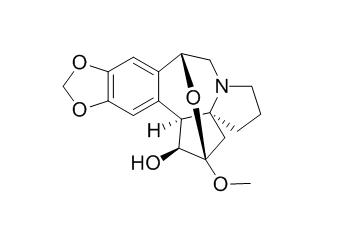Drupacine
Drupacine and a crude alkaloid extract suppress nematode hatch, activity of mixed life stages, and population numbers on plant roots.
Inquire / Order:
manager@chemfaces.com
Technical Inquiries:
service@chemfaces.com
Tel:
+86-27-84237783
Fax:
+86-27-84254680
Address:
1 Building, No. 83, CheCheng Rd., Wuhan Economic and Technological Development Zone, Wuhan, Hubei 430056, PRC
Providing storage is as stated on the product vial and the vial is kept tightly sealed, the product can be stored for up to
24 months(2-8C).
Wherever possible, you should prepare and use solutions on the same day. However, if you need to make up stock solutions in advance, we recommend that you store the solution as aliquots in tightly sealed vials at -20C. Generally, these will be useable for up to two weeks. Before use, and prior to opening the vial we recommend that you allow your product to equilibrate to room temperature for at least 1 hour.
Need more advice on solubility, usage and handling? Please email to: service@chemfaces.com
The packaging of the product may have turned upside down during transportation, resulting in the natural compounds adhering to the neck or cap of the vial. take the vial out of its packaging and gently shake to let the compounds fall to the bottom of the vial. for liquid products, centrifuge at 200-500 RPM to gather the liquid at the bottom of the vial. try to avoid loss or contamination during handling.
Appl. Sci. 2021, 11(17),7829
FASEB J.2019, 33(2):2026-2036
Molecules.2019, 24(10):E1930
J Ginseng Res.2022, 46(1):104-114.
Plos One.2020, 10.1371
Drug Chem Toxicol.2020, 1-12.
Revista Brasileira de Farmacognosia2021, 31:794-804.
Kasetsart University2022, ethesis.1144.
Evid Based Complement Alternat Med.2020, 2020:1970349.
Pharmacol Rep.2022, 74(1):175-188.
Related and Featured Products
Pest Manag Sci. 2013 Sep;69(9):1026-33.
Nematotoxicity of drupacine and a Cephalotaxus alkaloid preparation against the plant-parasitic nematodes Meloidogyne incognita and Bursaphelenchus xylophilus.[Pubmed:
23785026 ]
METHODS AND RESULTS:
Species of Cephalotaxus (the plum yews) produce nematotoxic compounds of unknown identity. Consequently, bioassay-guided fractionation was employed to identify the compound(s) in Cephalotaxus fortunei twigs and leaves with activity against plant-parasitic nematodes. A crude alkaloid extract, particularly Drupacine, was responsible for much of the nematotoxicity. The ED50 of Drupacine for Bursaphelenchus xylophilus was 27.1 μg mL⁻1, and for Meloidogyne incognita it was 76.3 μg mL⁻1. Immersion of M. incognita eggs in 1.0 mg mL⁻1 crude alkaloid extract (the highest tested concentration) reduced hatch by 36%; immersion of second-stage juveniles (J2) resulted in 72-98% immobility. Crude alkaloid extract and Drupacine suppressed protease activity in extracts of the microbivorous nematode Panagrellus redivivus by 50% and 80%, respectively. Application of 0.02-0.5 mg mL⁻1 crude alkaloid extract to soil with M. incognita inoculum did not significantly reduce pepper plant shoot length or weight, compared with nematode-inoculated, water-treated controls, but the number of eggs and J2 per root system respectively decreased by 69% and 73% at 0.5 mg mL⁻1.
CONCLUSIONS:
Drupacine and a crude alkaloid extract suppress nematode hatch, activity of mixed life stages, and population numbers on plant roots. This is the first demonstration of nematotoxicity of crude Cephalotaxus alkaloids and Drupacine.
Yao Xue Xue Bao. 2003 Dec;38(12):919-23.
Synthesis and antitumor activity of the derivatives of cephalotaxine and drupacine.[Pubmed:
15040085]
To make full use of cephalotaxus plant resources and search for antitumor agents with higher activities and lower side effects.
METHODS AND RESULTS:
The C3 hydroxy groups of the cephlotaxine and Drupacine were acylated by taxol side chain and its isomers to give a series of derivatives of cephlotaxine and Drupacine. Six novel alkaloid esters were designed and synthesized. The pharmacological screening results showed that VIIIa, VIIIb, IXa and IXc exhibited significant activities on KB, HCT and Bel in vitro.
CONCLUSIONS:
Novel alkaloid esters are worthy to be intensively studied.
J Chromatogr A. 2009 May 29;1216(22):4663-7.
Completed preparative separation of alkaloids from Cephaltaxus fortunine by step-pH-gradient high-speed counter-current chromatography.[Pubmed:
19393155 ]
Cephalotaxine-type alkaloids are the anti-cancer components in twigs, leaves, roots and seeds of Cephalotaxus fortunine. It is very important to use the limited resource by finding an efficient purification technology of the alkaloids.
METHODS AND RESULTS:
Separation of cephalotaxine-type alkaloids in Cephalotaxus fortunine by step-pH-gradient high-speed counter-current chromatography (step-pH-gradient HSCCC) was studied in this paper. The step-pH-gradient HSCCC was performed on a HSCCC instrument equipped with a 400-mL column, using the upper phase of ethyl acetate-n-hexane-water, with added 0.01% trifluoroacetic acid (TFA) as stationary phase, and the lower phase of ethyl acetate-n-hexane-water, with added 2% NH(4)OH, 0.2% NH(4)OH and 0.05% TFA as mobile phase. For each separation, 800mg of extract of cephalotaxine-type alkaloids was separated to yield 9.3mg of Drupacine, 15.9mg of wilsonine, 130.4mg of cephalotaxine, 64.8mg of epi-wilsonine, 12.8mg of fortunine and 35.6mg of acetylcephalotaxine with purities 81.2%, 85.7%, 95.3%, 97.5%, 89.1% and 96.2%, respectively.
CONCLUSIONS:
The recovery of each alkaloid was more than 90%. The structures of the six alkaloids were identified by electrospray ionization mass spectrum (ESI-MS) and (1)H and (13)C NMR.



